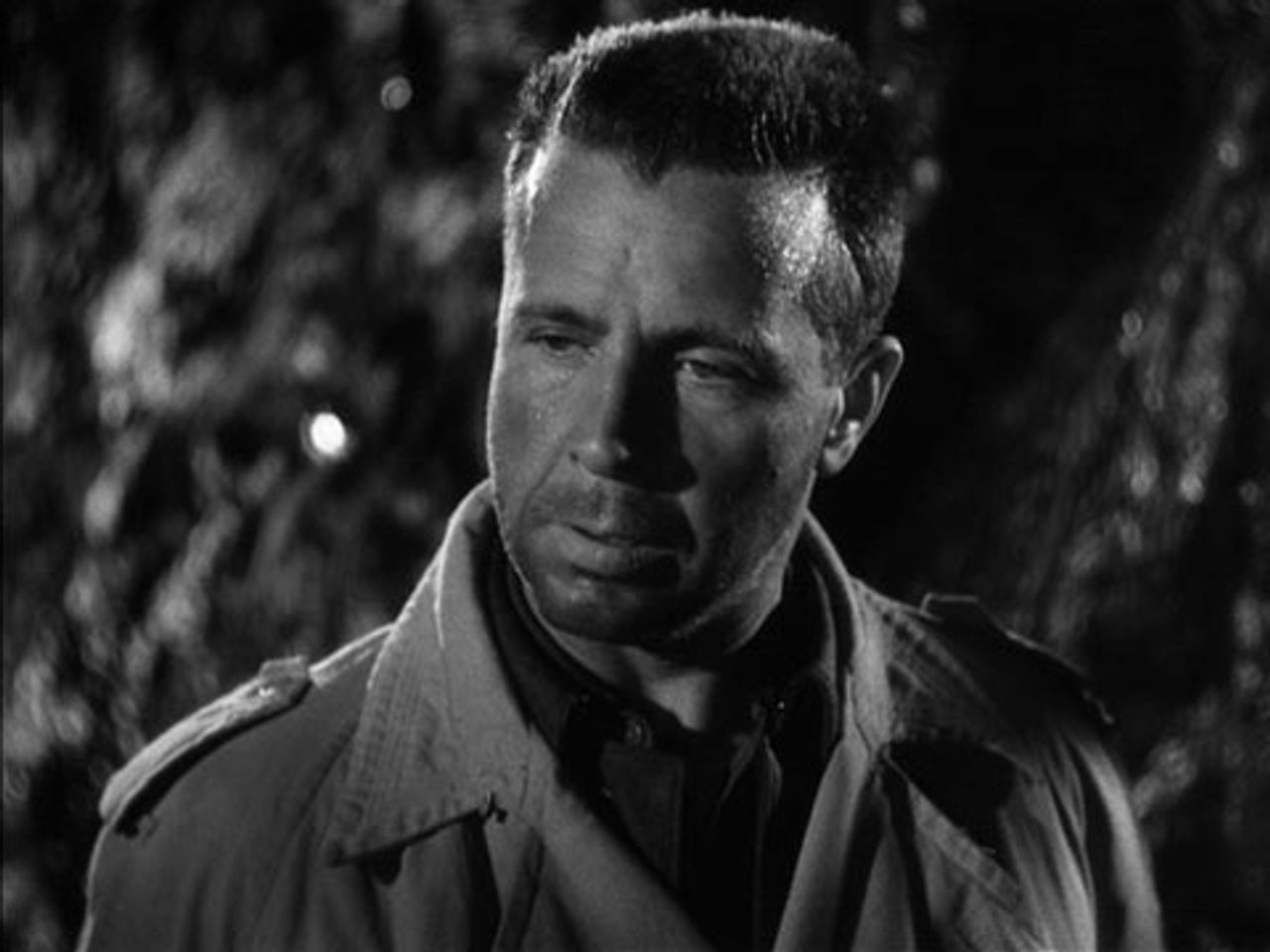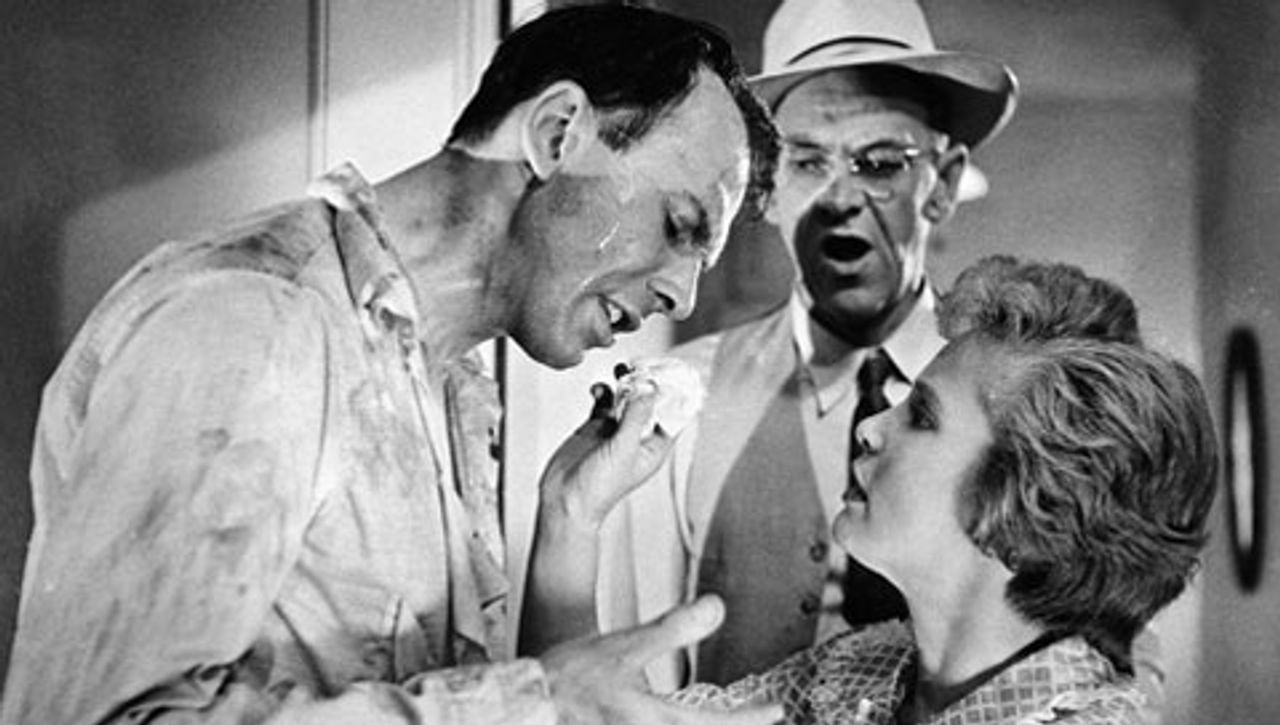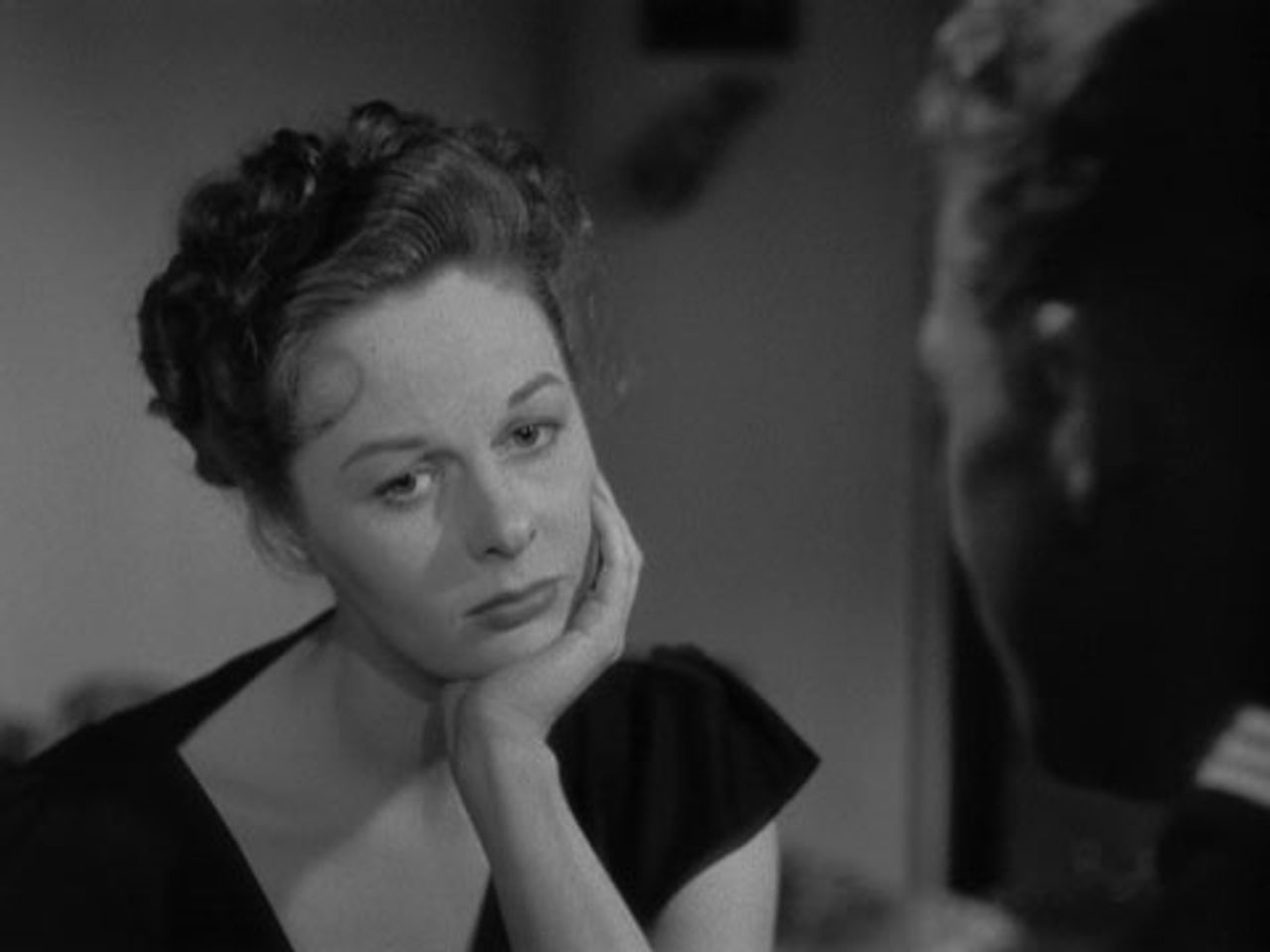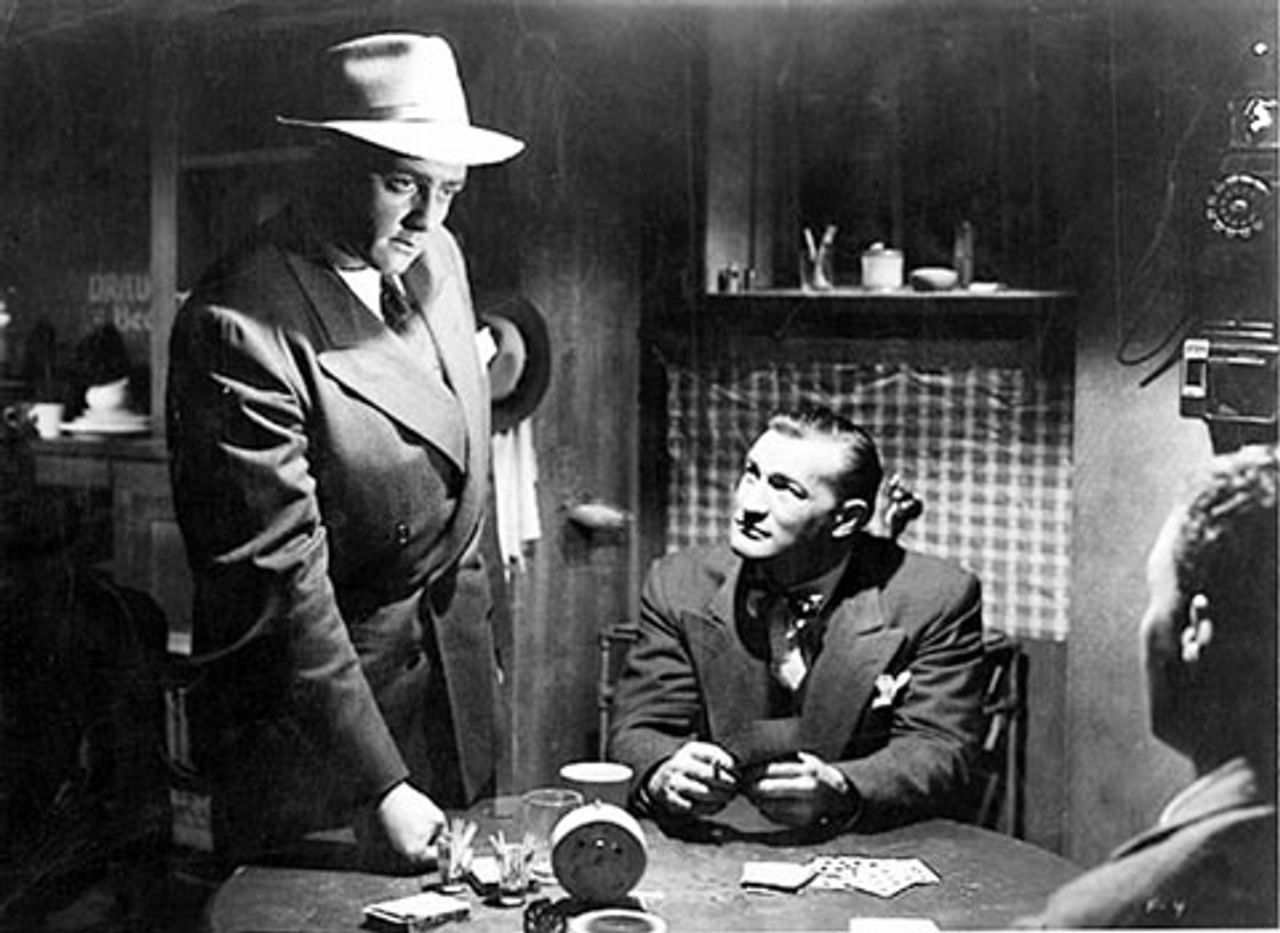Volume 5 of Warner Bros. Film Noir Classic Collection contains eight films made between 1945 and 1956. As has been the case with several recent releases in this and other film noir collections, there are no undiscovered masterpieces, and several of the movies are not noir.
At the same time, the overall quality of the choices ranges from the watchable to the remarkable. In addition, Volume 5 is the most politically overt collection yet, with the selections falling into two general categories: the difficulties confronting World War II veterans and the “enemy within” theme spawned by Cold War-induced fear and conformity.
Due to the number of films in this collection, this reviewer will focus on the best example of each category while devoting less, but well-deserved time to the other selections.
 Cornered
CorneredCornered (1945), directed by Edward Dmytryk (Tender Comrade, Murder, My Sweet, Crossfire, The Caine Mutiny) combines the hard-boiled detective plot of film noir with a first-rate exposé of the Nazi collaborators allowed to escape Europe and infest South America following the Second World War.
After being demobilized in London and given back pay accrued during his confinement in a prison camp in Nazi-occupied France, Canadian flyer Laurence Gerard (Dick Powell) returns to France to avenge the murder of his French wife (a member of the resistance) of only 20 days.
Once there, he discovers his wife and 50 other French resistance fighters were assassinated by Vichy Nazi collaborator Marcel Jarnac (Luther Adler). Gerard tracks his wife’s killer to Argentina, where he finds a nest of French expatriates (some of whom were also Vichy Nazi collaborators) and a group of agents also dedicated to catching the war criminal.
After a series of miscalculations and dead ends (mostly due to shortsightedness induced by his single-minded purpose), Gerard awakens to the larger, insidious forces at hand, which in turn allows him to finally discover the still-living Jarnac’s location and see justice done.
Male protagonists blinded by their own interests are a film noir staple, and given the deadly serious nature of this film, Powell rightly plays Gerard as an edgier, more determined version of his Philip Marlowe in 1944’s Murder, My Sweet (also directed by Dmytryk).
Walter Slezak is excellent as the bully Melchior Incza who plays both sides in the search for Jarnac. True to his character’s type, Slezak plays him as a slimy, unctuous figure to superiors (especially those with money) who turns vicious toward those beneath him.
In fact, true to another film noir staple, nearly everyone Gerard meets is not what he or she seems. Micheline Cherial’s Madeline Jarnac is another film noir female with a dual identity, and Nina Vale’s Senora Camargo is a more reserved, less acerbic version of earlier femme fatales.
Screenwriter John Paxton provides a well-researched script (from a story by John Wexley, a supporter of the Communist Party, like Dmytryk at the time) appropriate to its subject. The dialogue isn’t as quick and witty as in Murder, My Sweet, but that kind of playfulness would have undermined the serious tone of this film. Paxton does give Gerard well-placed sarcastic barbs that leaven the character’s almost robotic single-mindedness, e.g., to Senora Camargo’s “Shall I be honest?” Gerard replies, “Don’t strain yourself.”
Dmytryk would later go to jail in 1950 as one of the “Hollywood Ten,” and then recant, shamelessly turning anti-communist informer in testimony before the House Committee on Un-American Activities (HUAC) in 1951. The producer of Cornered (and of three of Dmytryk’s other films), Adrian Scott, was another of the “Ten” who spent time in prison. Dmytryk named Scott before HUAC.
 The Phenix City Story
The Phenix City StoryThe Phenix City Story (1955), directed by Phil Karlson with screenplay by Daniel Mainwaring (Out of the Past, Invasion of the Body Snatchers), is based on actual events that occurred in Phenix City, Alabama, across the river from Fort Benning in Columbus, Georgia. The movie’s compelling portrait of the threat to democracy from within is marred by a simplistic solution to the problem.
Army lawyer John Patterson (Richard Kiley) returns from prosecuting war criminals at the Nuremburg trials to find his hometown threatened by local despots. To control its illegal profits from gambling and prostitution, a syndicate, led by Rhett Tanner (Edward Andrews), also controls the courts and local police, who openly beat Phenix City citizens for attempting to vote against syndicate-sponsored candidates.
Initially indifferent to his town’s plight (“I’ve been through one war already”), Patterson changes his mind after witnessing violence and killings. With the help of Ellie Rhodes (Kathryn Grant) and his father, lawyer Albert Patterson (John McIntire), he finally convinces the state of Alabama to intervene.
Shot on location in documentary style, the movie begins with an “Eye Witness Report” in which Phenix City citizens are interviewed concerning the events depicted in the movie. The actors bring purpose and passion to their roles. Kiley is particularly effective in portraying his character’s growing awareness of what is occurring, and the underrated Andrews plays Tanner as a congenial small-town mob boss who orders killings as readily and easily as he charms elderly women.
Mainwaring’s script is at once enlightening and frustrating, for he exhibits a consciousness of social inequality and corruption in early 1950s’ America, but offers little more than high school civics solutions to these problems.
Early in the movie, we learn that Tanner’s Poppy Club (a gambling house) is the only place in town where a woman can make $200 a week, while a law student working as an intern makes $50 a week. Ellie Rhodes, a card dealer at the Poppy Club, presents the situation succinctly: “Nobody is going to take down the Poppy Club, because there’s too much profit to be made.”
We also learn that a leading member of a Christian group formed to fight the syndicate is an informer for Tanner. Later, Patterson asks the citizens to recognize the danger they’re facing: “Where does this happen? Just in some dictatorship across the sea?”
As the Phenix City citizens begin to fight back, graphic visual images convey the increasingly reactionary and brutal measures taken by the Tanner syndicate. Extreme close-ups register the growing fear among the citizens.
Yet, the only answer to these outrages is the repeated message to vote and finally to bring the state militia into Phenix City and declare martial law. In a final bit of irony, the real Patterson would be elected governor of Alabama in 1958 after having run a blatantly racist campaign.
The filmmakers’ inability to offer more in-depth analysis, much less real solutions—no doubt at least partially due to the intimidation generated by the anti-communist witch-hunts—should not take away from an appreciation for the film’s valuable portrayal of the real threat to democracy.
 Deadline at Dawn
Deadline at DawnDirected by Harold Clurman, with a screenplay by left-wing writer Clifford Odets, Deadline at Dawn (1946) features a fine performance by Susan Hayward, plus a healthy dose of film noir atmospherics.
Suspected of killing a woman, Alex Winkley (Bill Williams), a sailor on leave, has until dawn to discover who actually killed her and clear himself. June Goth (Susan Hayward), Gus Hoffman (Paul Lukas) and several other characters of varying degrees of respectability become entangled in the search. After a process of elimination, the killer is the last person one would have suspected of being a murderer.
Hayward’s face could never tell a lie, a gift that serves her well as the taxi-dancer June Goth. At first possessed of a stiffened cynicism borne of too many groping hands, Goth gradually reveals a vulnerability and natural sensuality as she learns to trust Alex and Gus. Camera angles and fade-outs add layers of meaning to the story. The film’s only drawbacks are an Alex Winkley who is a little too innocent for a sailor on leave and a script that is more convoluted than it need be.
 Desperate
DesperateDirector Anthony Mann’s Desperate (1947) features a number of film noir stylistics and theme, as well as solid performances by Steve Brodie and Raymond Burr.
Brodie’s Steve Randall is an everyman veteran who unwittingly becomes part of a gang led by pre-war friend Walt Radak (Burr) and, following a heist gone awry, escapes with his pregnant wife Anne (Audrey Long). Living by their wits, Randall and his wife become (unjustly) celebrated gang members and murderers, à la Bonnie and Clyde, a motif common to film noir. By the end, Randall manages to prove his innocence.
Brodie’s Randall is a steady, believable character, while Burr is his usual convincing self as the sinister, shadowy figure he played so well in a number of his early movies. Mann uses common objects, i.e., swinging lights, extreme camera angles, and both natural light and chiaroscuro to convey ambiguity and a sense of foreboding.
1950’s Backfire (the story takes place in 1948) is watchable, but a number of fine actors are wasted or miscast, i.e., Edmond O’Brien (Steve Connolly) and Ed Begley (Police Capt. Garcia) are not given enough screen time, and the always compelling Virginia Mayo is impossibly cast as a nice, ordinary nurse. Gordon MacCrae, a capable actor, seems muted in his role as a World War II veteran recovering from an injury and trying to clear his friend Steve Connolly of a wrongful charge of murder.
The movie does work with a theme common to film noir: post-World War II America did not lay out the welcome mat for its veterans. An innocent man (Connolly) is suspected of murder due to significant coincidental evidence, and one of the veteran’s army buddies, Ben Arno (Dane Clark), is forced to work at a mortuary when he can’t get a loan to open a nightclub. Still, the movie doesn’t live up to its cast’s promise.
In Armored Car Robbery (1955), director Richard Fleisher also draws heavily on film noir stylistics and characters, but with a much more satisfying result.
The film is shot on location in documentary style (the opening interior shots of the Chicago Police Department immediately establish a sense of verisimilitude that carries through the movie), and the attention to detail is first rate. Low-angle, extreme close-up shots foreshadow criminals, and flat light exterior shots add to the realism of daylight scenes.
Adele Jergens’ Yvonne DeVeux is a hardboiled stripper in a burlesque club who’s seen enough to make her a little impatient with men. In short, she is a Virginia Mayo-type femme fatale with the slightest frailty around the edges. William Talman plays gang leader Dave Purvis as the careful, detail-oriented criminal who is just as smart (and maybe smarter) than the police who are tracking him. (Talman, a gifted performer, gained most prominence as the unfortunate district attorney Hamilton Burger, who never won a case against Raymond Burr’s Perry Mason in the television series of the same name, 1957-1966.)
Armored Car Robbery is a tight, well-acted bank heist movie; it’s one of the better late noir films.
The production values of director Don Siegel’s Crime in the Streets (1956) are not up to its “troubled teen” contemporaries Blackboard Jungle and Rebel Without a Cause, but several touching scenes surpass anything found in those more famous movies.
In his cinema debut, John Cassavetes (in his late 20s already, impersonating a teenager!) plays Frankie Dane as a once intelligent, sensitive boy who, due to an absent father and living conditions that offer no hope, now leads a street gang and threatens to kill a “snitch.”
Siegel’s direction and Sam Levitt’s photography deliver poignant, meaningful images that build to the crescendo of three emotionally charged scenes: Frankie’s mother, played by Virginia Gregg, reacting to her son’s demand that she never touch him; gang member Angelo “Baby” Gioia’s (Sal Mineo) father telling his son how much he misses the little boy he once was; and the final, powerful scene between Frankie and his little brother, Richie (Peter Votrian). There’s not a false note in any of these scenes.
Dial 1119 (1950), directed by Gerald Mayer, which takes a different turn with the “threat from within” theme, is one of the collection’s lesser selections, but it, too, has its moments.
An escaped asylum inmate, Gunther Wyckoff (Marshall Thompson), holds six people hostage in a bar as a means of drawing out Dr. John Faron, played by Sam Levene (another left-wing performer), whose testimony sent him to the asylum. Before he is himself killed by police, the escaped inmate kills the bartender, “Chuckles” (played by William Conrad), and Faron, leaving the former hostages to rethink their lives.
Several scenes are well-written and acted; the scene in which a desperately needy Wyckoff calls the newspaper desk and a reporter tells him what’s happening in the newsroom, step by step, stands out. The film also use the then-new medium, television, creatively. A TV news truck stationed outside the bar allows Wycoff to watch Dr. Faron walk to the bar. But the actors playing the hostages are too complacent to elicit much concern for their fate.
The quality of the transfer to DVD is mostly good to very good. Unfortunately, there are no commentaries included.
